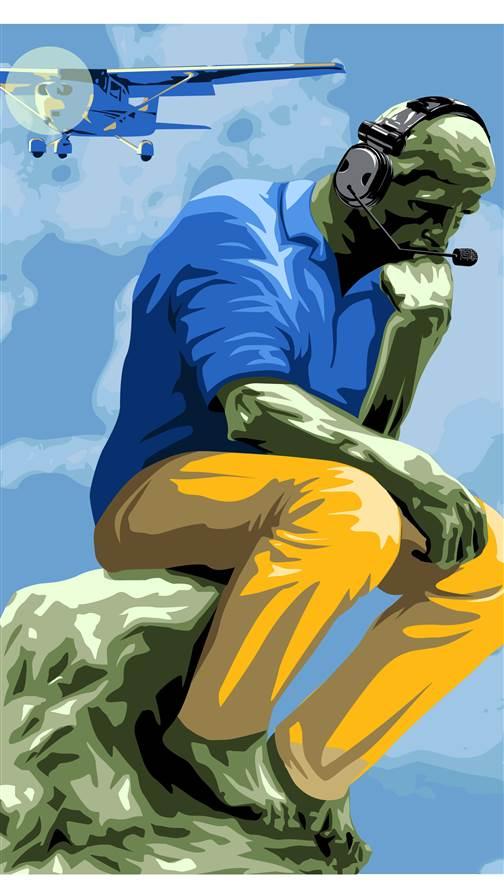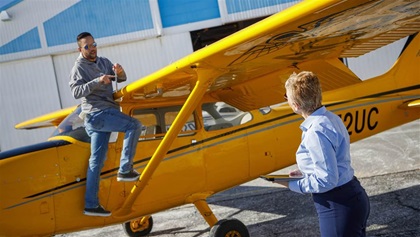Good to great
To stay sharp, evaluate yourself on every flight

In almost every endeavor, getting perspective from a fresh set of eyes makes things better. That’s why the FAA requires pilots to fulfill the requirements for a flight review every 24 calendar months to fly as pilot in command. However, that’s not to say that the only time a critical set of eyes should be cast upon our flying is during a flight review. Every time we strap on an airplane, our own eyes should be the critical ones. Within certain limits, we should treat every flight like a flight review.
Every flight regime has elements pilots can easily evaluate. From walking out onto the ramp to unstrapping and getting out of the airplane, during each flight we can look at every one of the primary tasks and judge how accurately and correctly we’re doing them.
Perform a detailed preflight—every time. A preflight inspection is not just checking the oil and fuel and walking around the airplane looking for parts that may be falling off. We should be inspecting every mechanical factor that is critical to that particular type of airplane.
Taxi out with care. Courtesy, consideration, and safety should be central to taxiing. On nontowered fields, give way to other traffic. On all airports, when coming into the run-up area, try to position your airplane so you’re as far out of the way as possible to let heavier aircraft make it to the runway. Don’t park in the middle of the hold-short line as if you own the airport. On many airports there will be departing IFR traffic that has a timed departure. Be considerate.
Hold centerline on takeoff. The centerline stripe is about a foot wide and you’ll know you’ve done your job if the nose stays right on that stripe as the airplane accelerates.
Set an attitude for takeoff. As the airplane gains speed and the elevators are effective, gently pick the nose off the ground and establish a shallow, nose-high attitude with the main gear still on the ground. That is held until the airplane flies itself off. Don’t force it off the ground. This guarantees that the airplane is ready to fly.
Establish and control climb speed. Immediately after takeoff establish and hold best rate, or angle, speed within two knots. That means being aware of the nose attitude and making small changes to hold the speed.
 Correct for wind drift on climbout. We don’t have rearview mirrors in most airplanes, but we do our best to monitor the airplane’s ground track on climb and stay on the extended centerline.
Correct for wind drift on climbout. We don’t have rearview mirrors in most airplanes, but we do our best to monitor the airplane’s ground track on climb and stay on the extended centerline.
Control for P-factor in the climb. During the climb and while at full power, just enough right rudder is held to keep the skid ball exactly in the middle for maximum climb efficiency. Any yaw, as indicated by a displaced ball, is eating into the rate of climb.
Level out and hold altitude. As the desired altitude is approached, gently lower the nose to level, then hesitate a second or two to let it begin to accelerate before bringing the power back to cruise settings. If the power is retarded during the push-over, the airplane will have a tendency to lose a little altitude as it accelerates.
Hold an exact heading. While on course, as determined by pilotage (landmarks) or GPS, determine the heading on the compass or heading indicator and hold it within a few degrees.
Visualize and hold a course line. While holding your heading, identify a landmark on course ahead of you and monitor to see if the heading is taking you toward that landmark. If not, adjust the heading a few degrees to correct for wind at that altitude.
Correctly use navaids. Rather than blindly trusting the GPS, back up your navigation with a paper or digital sectional chart. If the GPS screen you’ve been following goes dark, you’ll know where you are and the correct compass heading to be held.
 Plan your traffic pattern entry. Well before reaching the airport, determine the appropriate entry to the pattern and visualize flying it. This might mean over-flying at a higher altitude for a better entry position.
Plan your traffic pattern entry. Well before reaching the airport, determine the appropriate entry to the pattern and visualize flying it. This might mean over-flying at a higher altitude for a better entry position.
Exhibit situational awareness vis-à-vis other traffic. You’ve drawn the pattern in your mind and visualized where it lies on the ground ahead. While entering the pattern and flying it, constantly search all the legs and the general area for traffic. Pay attention to position reports from other aircraft in the pattern, and scan the area for other aircraft that may not be reporting.
Make appropriate configuration changes. Flaps, if available, are extended at the speeds listed in the pilot’s operating handbook and in the position that matches the airplane, the type of approach (power-on, power-off, for instance), and the runway.
Identify the desired touchdown point and hold the approach path to it. On approach, pilots should be focused on the threshold or numbers and have selected a spot approximately 500 feet down the runway as the touchdown point. Aim your approach path at the numbers or threshold, knowing you’ll float well past them while flaring. Hold the aiming point visually fixed in the windshield: If it’s moving up, you’re short, if moving down, you’ll land long.
 Control your speed. Keep the speed within three knots (preferably less) of the desired speed.
Control your speed. Keep the speed within three knots (preferably less) of the desired speed.
Flare at the proper height and burn off speed. Make it gradual, make it smooth.
Touch down on the mains and hold the nose off. To anyone watching, that kind of landing puts you in the rare group of people who add “pretty” to the list of adjectives that describe their landings. It’s a small, but easy to accomplish, detail that separates the real pilots from the drivers. Just hold the nose wheel clear of the runway, but don’t hold it there until it falls on its own. Gradually release the pressure and let it touchdown lightly.
Coast to a stop, with minimum braking. Everything about the landing, including the stop, should be smooth, with a certain amount of grace involved.
So, flight over, how did you do? If you want, you can establish a grading system. However, this doesn’t have to be a rigid contest in which you’re competing with yourself all of the time. It can be nothing more than a mental checklist that makes you aware of everything you’re doing in the airplane. So, in general terms, you judge each of those factors against what you know they should be. The hope is that just the knowledge that there’s a right and not-so-right way to do things will always be guiding your efforts. This awareness alone will make you a better, safer pilot.
What’s holding you back?
Reasons pilots’ skills are not what they should be
The main reasons pilots make mistakes or don’t fly up to their capabilities include, but are not limited to:
- We don’t know any better. Students may go all the way through training without understanding something basic, like P-factor or adverse yaw. Whether because they were taught something wrong or misunderstood a lesson, students often carry that misunderstanding with them for the rest of their careers unless that lack of knowledge is corrected.
- Precision was not emphasized. One of the factors that separate good pilots from really good pilots is exactitude. However, that is not a skill. It is actually a mental attitude in which the pilot decides what kind of aviator she’s going to be: precise or so-so.
- We’ve gotten lazy.Because there are no telephone poles, highway stripes, or oncoming traffic zipping by only 15 feet away, there’s a much wider latitude in flying that encourages being lazy.
- We aren’t scanning.The necessity of continually scanning wing tip to wing tip, which includes dipping down into the panel to monitor speeds, altitude, headings, and more, can’t be over-emphasized. The moment we fixate on one thing, something else will drift off.
- We spend too much time with our eyes on the panel. Just about everything that’s presented on the panel, except the engine information, is historical information. Changes in altitude and airspeed take time to register on the gauges so pilots will be behind in making corrections if they rely on the instruments. Control the nose and everything else will fall into place.
- Our visual perception isn’t what it should be. Visual perception is more than just looking out the window to see where we’re going. If we aren’t constantly being hypercritical to what we’re seeing in terms of attitude, glide slope, course, ground track, and more, we’ll always be just a little late in making corrections. We can’t fix what we can’t see, and the sooner we fix something the smaller the corrections will be.
- Our butts are under-educated. In aviation, “flying by the seat of their pants” isn’t a personal insult. The sensitivity of your posterior to sideways movements (yaw) is a direct correlation to your ability to keep the ball in the center of the inclinometer. Long before your eyes pick up the skid ball sneaking off center, your butt is telling you what’s happening.
- It has been too long since getting dual time. Flight reviews are two years apart. For some pilots that’s too long. A good investment is buying an hour or so of CFI time once a year to work out the kinks in crosswind landings, short-field work, or some other area of focus.
- Not planning ahead and crisis management. There’s an old saying, “Don’t take your airplane anywhere that your brain hasn’t already been to.” By visualizing well ahead of the airplane we know what needs to be done and when, instead of constantly playing catch up.
- Situational awareness is lacking. Essentially an airplane is a ship sailing through a three-dimensional sea, and its captain has to constantly be aware of where he is in relation to his course, his destination, and other ships in his area. Far too many pilots don’t keep track of where they are in relation to the airport or other aircraft that are inbound to that same airport. —BD


